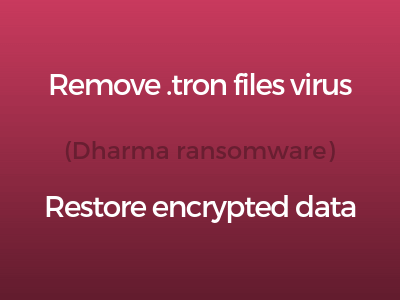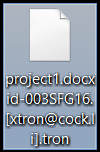This article gives insight on the issues caused by .tron files virus and provides a complete guide on how to remove malicious files from your infected PC and recover files encrypted by this ransomware.
The crypto virus .tron infects computer systems aiming to encode data and extort ransom payment from victims. In case that your computer has been affected by this ransomware, you won’t be able to open valuable files until you utilize an efficient recovery solution that could revert back their original code. Have in mind that the decrypter possessed by hackers is not the only possible way to restore .tron files.

Threat Summary
| Name | .tron Files Virus |
| Type | Ransomware, Cryptovirus |
| Short Description | Strain of Dharma ransomware that is configured to plague computer systems, corrupt valuable files stored on them and blackmial victims into paying ransom to hackers. |
| Symptoms | Important files are encrypted and marked with .tron extension. You could not open them until their code is reverted back to original state. A ranson note appears on screen to extort ransom for their decryption. |
| Distribution Method | Spam Emails, Email Attachments, Corrupted Web Pages |
| Detection Tool |
See If Your System Has Been Affected by malware
Download
Malware Removal Tool
|
User Experience | Join Our Forum to Discuss .tron Files Virus. |
| Data Recovery Tool | Windows Data Recovery by Stellar Phoenix Notice! This product scans your drive sectors to recover lost files and it may not recover 100% of the encrypted files, but only few of them, depending on the situation and whether or not you have reformatted your drive. |

.tron Files Virus – Distribution
Several spread techniques are likely to be utilized for the attack campaigns of .tron crypto virus. As a primary one is believed to be the so-called malspam. Often hackers embed their malicious code to various commonly used types of files. Malspam let hackers to easily spread these infected files in the form of email attachments and this way trick users into infecting their systems with .tron ransomware.
So is you have recently received legitimate like email with an attached file and got tricked into downloading and starting the attached file on your device you might have unintentionally infected your system with this devastating threat.
A variety of common file types such as documents, PDFs, images could be transformed into carriers of ransomware code.
These files are often presented as the following:
- Invoices coming from reputable sites, like PayPal, eBay, etc.
- Documents from what appears to be the victim’s bank.
- An online order confirmation note.
- Receipt for a purchase.
- Others.
The authors of Darma .tron might have also victimized you by tricking you to click an URL of a corrupted web page. Such pages could be set to trigger a drive-by download attack the moment you load them in your browser. This attack exploits existing browser vulnerabilities in order to deliver malicious files directly on your device. So be advised to keep all your installed web browsers patched and all downloaded browser apps running their latest versions.

.tron Files Virus – Overview
Discovered back in 2016 Dharma ransomware is one of the most popular malicious infections that is still harassing computer users worldwide. Since its first iteration had been spotted in the wild many other variants were released in massive attack campaigns. As identified by security experts the so-called .tron files virus is one of the freshest Dharma ransomware strains that is currently infecting online users.
Like its predecessors among which are [wplinkpreview url=”https://sensorstechforum.com/combo-files-virus-dharma-ransomware-remove-restore-files/”]Dharma .combo, [wplinkpreview url=”https://sensorstechforum.com/bip-files-virus-dharma-ransomware-remove-restore-files/”]Dharma .bip and [wplinkpreview url=”https://sensorstechforum.com/adobe-files-virus-dharma-remove/”]Dharma .adobe, this strain aims to establish its malicious files on the system and run them to implement significant system changes without being detected by active security measures.
There are several common system folders where ransomware files are often stored:
- %Roaming%
- %Windows%
- %AppData%
- %Local%
- %Temp%
Since .tron files virus is a threat with highly complex code, it could use many other system directories to store malicious files and objects. Don’t worry if you find it difficult to manually detect and delete all malicious as it could be a hard task even for tech-savvy users.
Analyses of .tron samples reveal that it is a threat that could access various system components in order to complete its main purpose – data encryption. So before encryption stage, the ransomware manipulates legitimate system processes, hijacks their functionalities, enters various complicated commands in the command control panel and applies changes in the Registry Editor.
Among the issues that could be observed after the completion of all needed changes is the automatic execution of .tron files virus on each system start. How it achieves this is by adding its malicious values under Run and RunOnce registry sub-keys.
→HKEY_CURRENT_USER\Software\Microsoft\Windows\CurrentVersion\
HKEY_LOCAL_MACHINE\Software\Microsoft\Windows\CurrentVersion\
By manipulating their functionalities Dharma .tron ransomware is also able to open its ransom message on the screen. The message is contained in a file called xtron@cock.li and all it reads is:
All your files have been encrypted!
All your files have been encrypted due to a security problem with your PC. If you want to restore them, write us to the e-mail
Write this ID in the title of your message
In case of no answer in 24 hours write us to theese e-mails:
You have to pay for decryption in Bitcoins. The price depends on how fast you write to us. After payment we will send you the decryption tool that will decrypt all your files.Free decryption as guarantee
Before paying you can send us up to 1 file for free decryption. The total size of files must be less than 1mb (non archived), and files should not contain valuable information. (databases,backups, large excel
sheets, etc.)How to obtain Bitcoins
The easiest way to buy bitcoins is LocalBitcoins site. You have to register, click ‘Buy bitcoins’, and select the seler by payment method and price.
httgs:[[localbitcoins.com[buy bitcoins
Also you can find other places to buy Bitcoins and beginners guide here:
https://www.coindesk.com/information/how-can-i-buy-bitcoins/Attention!
Do not rename encrypted files.
Do not try to decrypt your data using third party software, it may cause permanent data loss.
Decryption of your files with the help of third parties may cause increased price (they add their fee to our) or you can become a victim of a scam.
At this point, there is no information about the demanded ransom amount. The guesses are that it will vary from 0.1 to 1.0 BTC and hackers will want it to be transferred to their Bitcoin address. No matter of the amount we advise you to avoid contacting them as this could only lead to further security-related issues and money losses.

.tron Files Virus – Encryption Process
Why can’t you open .tron files? Because their original code has been transformed via sophisticated cipher algorithm during the encryption process. After Dharma .tron ransomware activates its built-in encryption module it leaves all important files useless and extorts a ransom for their decryption.
Here are all the files that may be corrupted by this ransomware:
- Audio files
- Video files
- Document files
- Image files
- Backup files
- Banking credentials, etc
Once encrypted the names of these files are also different than the initial ones. Analyses of .tron virus samples reveal that it is configured to rename corrupted files by following the pattern:
- .id-[your uniquely generated ID].[xtron@cock.li].tron
So on the right is how a document file called project1.docx will look like after being encrypted by .tron ransomware:
We know that the restoration of your .tron files is of paramount importance. In our guide, you will find alternative ways to potentially restore encrypted files without contacting hackers. Any negotiations with them could lead to additional issues related to the privacy of your sensitive credentials.

Remove .tron Files Virus and Restore Data
The so-called .tron files virus is a threat with highly complex code that plagues not only your files but your whole system. So infected system should be cleaned and secured properly before you could use it regularly again. Below you could find a step-by-step removal guide that may be helpful in attempting to remove Kraken Cryptor v2.2 ransomware. Choose the manual removal approach if you have previous experience with malware files. If you don’t feel comfortable with the manual steps select the automatic section from the guide. Steps there enable you to check the infected system for ransomware files and remove them with a few mouse clicks.
In order to keep your system safe from ransomware and other types of malware in future, you should install and maintain a reliable anti-malware program. Additional security layer that could prevent the occurrence of ransomware attacks is [wplinkpreview url=”https://sensorstechforum.com/the-most-popular-free-anti-ransomware-tools/”]anti-ransomware tool.
Make sure to read carefully all the details mentioned in the step “Restore files” if you want to understand how to fix encrypted files without paying the ransom. Beware that before data recovery process you should back up all encrypted files to an external drive as this will prevent their irreversible loss.
- Step 1
- Step 2
- Step 3
- Step 4
- Step 5
Step 1: Scan for .tron Files Virus with SpyHunter Anti-Malware Tool



Ransomware Automatic Removal - Video Guide
Step 2: Uninstall .tron Files Virus and related malware from Windows
Here is a method in few easy steps that should be able to uninstall most programs. No matter if you are using Windows 10, 8, 7, Vista or XP, those steps will get the job done. Dragging the program or its folder to the recycle bin can be a very bad decision. If you do that, bits and pieces of the program are left behind, and that can lead to unstable work of your PC, errors with the file type associations and other unpleasant activities. The proper way to get a program off your computer is to Uninstall it. To do that:


 Follow the instructions above and you will successfully delete most unwanted and malicious programs.
Follow the instructions above and you will successfully delete most unwanted and malicious programs.
Step 3: Clean any registries, created by .tron Files Virus on your computer.
The usually targeted registries of Windows machines are the following:
- HKEY_LOCAL_MACHINE\Software\Microsoft\Windows\CurrentVersion\Run
- HKEY_CURRENT_USER\Software\Microsoft\Windows\CurrentVersion\Run
- HKEY_LOCAL_MACHINE\Software\Microsoft\Windows\CurrentVersion\RunOnce
- HKEY_CURRENT_USER\Software\Microsoft\Windows\CurrentVersion\RunOnce
You can access them by opening the Windows registry editor and deleting any values, created by .tron Files Virus there. This can happen by following the steps underneath:


 Tip: To find a virus-created value, you can right-click on it and click "Modify" to see which file it is set to run. If this is the virus file location, remove the value.
Tip: To find a virus-created value, you can right-click on it and click "Modify" to see which file it is set to run. If this is the virus file location, remove the value.
Before starting "Step 4", please boot back into Normal mode, in case you are currently in Safe Mode.
This will enable you to install and use SpyHunter 5 successfully.
Step 4: Boot Your PC In Safe Mode to isolate and remove .tron Files Virus





Step 5: Try to Restore Files Encrypted by .tron Files Virus.
Method 1: Use STOP Decrypter by Emsisoft.
Not all variants of this ransomware can be decrypted for free, but we have added the decryptor used by researchers that is often updated with the variants which become eventually decrypted. You can try and decrypt your files using the instructions below, but if they do not work, then unfortunately your variant of the ransomware virus is not decryptable.
Follow the instructions below to use the Emsisoft decrypter and decrypt your files for free. You can download the Emsisoft decryption tool linked here and then follow the steps provided below:
1 Right-click on the decrypter and click on Run as Administrator as shown below:

2. Agree with the license terms:
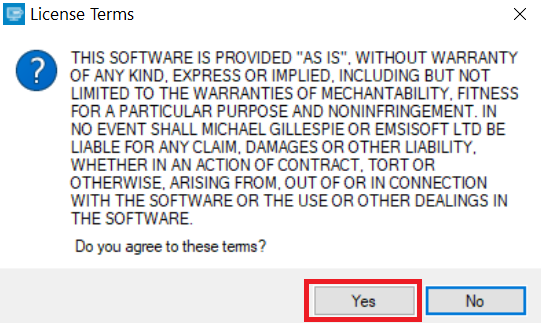
3. Click on "Add Folder" and then add the folders where you want files decrypted as shown underneath:
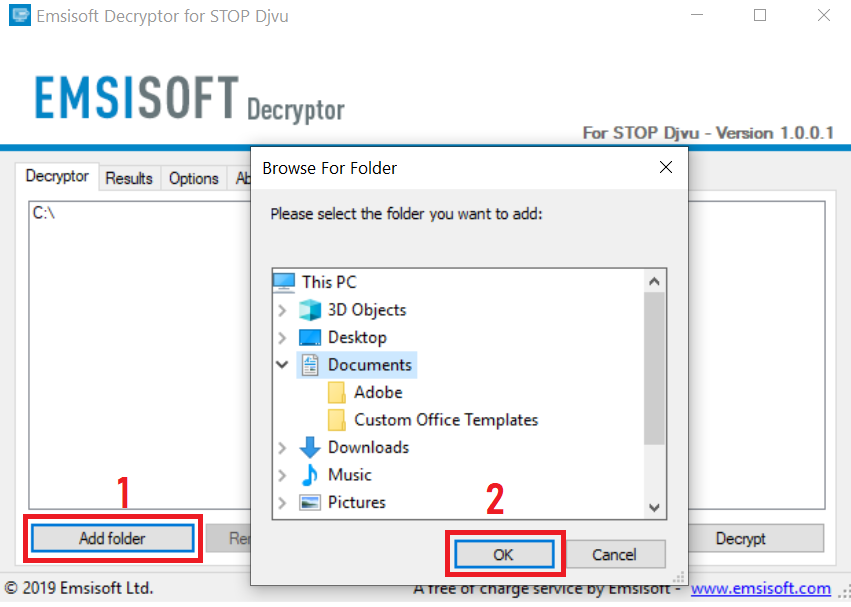
4. Click on "Decrypt" and wait for your files to be decoded.
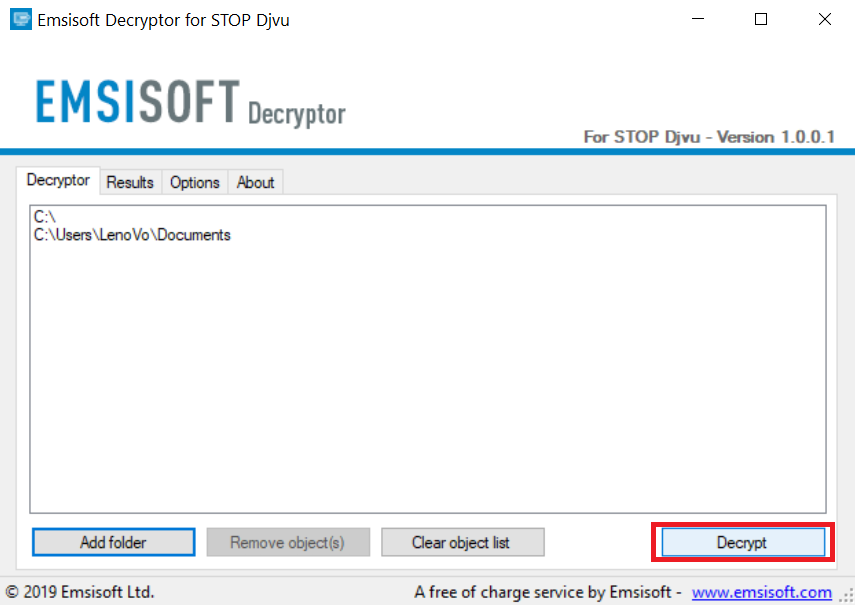
Note: Credit for the decryptor goes to Emsisoft researchers who have made the breakthrough with this virus.
Method 2: Use data recovery software
Ransomware infections and .tron Files Virus aim to encrypt your files using an encryption algorithm which may be very difficult to decrypt. This is why we have suggested a data recovery method that may help you go around direct decryption and try to restore your files. Bear in mind that this method may not be 100% effective but may also help you a little or a lot in different situations.
Simply click on the link and on the website menus on the top, choose Data Recovery - Data Recovery Wizard for Windows or Mac (depending on your OS), and then download and run the tool.
.tron Files Virus-FAQ
What is .tron Files Virus Ransomware?
.tron Files Virus is a ransomware infection - the malicious software that enters your computer silently and blocks either access to the computer itself or encrypt your files.
Many ransomware viruses use sophisticated encryption algorithms to make your files inaccessible. The goal of ransomware infections is to demand that you pay a ransom payment to get access to your files back.
What Does .tron Files Virus Ransomware Do?
Ransomware in general is a malicious software that is designed to block access to your computer or files until a ransom is paid.
Ransomware viruses can also damage your system, corrupt data and delete files, resulting in the permanent loss of important files.
How Does .tron Files Virus Infect?
Via several ways..tron Files Virus Ransomware infects computers by being sent via phishing emails, containing virus attachment. This attachment is usually masked as an important document, like an invoice, bank document or even a plane ticket and it looks very convincing to users.
Another way you may become a victim of .tron Files Virus is if you download a fake installer, crack or patch from a low reputation website or if you click on a virus link. Many users report getting a ransomware infection by downloading torrents.
How to Open ..tron Files Virus files?
You can't without a decryptor. At this point, the ..tron Files Virus files are encrypted. You can only open them once they are decrypted using a specific decryption key for the particular algorithm.
What to Do If a Decryptor Does Not Work?
Do not panic, and backup the files. If a decryptor did not decrypt your ..tron Files Virus files successfully, then do not despair, because this virus is still new.
Can I Restore "..tron Files Virus" Files?
Yes, sometimes files can be restored. We have suggested several file recovery methods that could work if you want to restore ..tron Files Virus files.
These methods are in no way 100% guaranteed that you will be able to get your files back. But if you have a backup, your chances of success are much greater.
How To Get Rid of .tron Files Virus Virus?
The safest way and the most efficient one for the removal of this ransomware infection is the use a professional anti-malware program.
It will scan for and locate .tron Files Virus ransomware and then remove it without causing any additional harm to your important ..tron Files Virus files.
Can I Report Ransomware to Authorities?
In case your computer got infected with a ransomware infection, you can report it to the local Police departments. It can help authorities worldwide track and determine the perpetrators behind the virus that has infected your computer.
Below, we have prepared a list with government websites, where you can file a report in case you are a victim of a cybercrime:
Cyber-security authorities, responsible for handling ransomware attack reports in different regions all over the world:
Germany - Offizielles Portal der deutschen Polizei
United States - IC3 Internet Crime Complaint Centre
United Kingdom - Action Fraud Police
France - Ministère de l'Intérieur
Italy - Polizia Di Stato
Spain - Policía Nacional
Netherlands - Politie
Poland - Policja
Portugal - Polícia Judiciária
Greece - Cyber Crime Unit (Hellenic Police)
India - Mumbai Police - CyberCrime Investigation Cell
Australia - Australian High Tech Crime Center
Reports may be responded to in different timeframes, depending on your local authorities.
Can You Stop Ransomware from Encrypting Your Files?
Yes, you can prevent ransomware. The best way to do this is to ensure your computer system is updated with the latest security patches, use a reputable anti-malware program and firewall, backup your important files frequently, and avoid clicking on malicious links or downloading unknown files.
Can .tron Files Virus Ransomware Steal Your Data?
Yes, in most cases ransomware will steal your information. It is a form of malware that steals data from a user's computer, encrypts it, and then demands a ransom in order to decrypt it.
In many cases, the malware authors or attackers will threaten to delete the data or publish it online unless the ransom is paid.
Can Ransomware Infect WiFi?
Yes, ransomware can infect WiFi networks, as malicious actors can use it to gain control of the network, steal confidential data, and lock out users. If a ransomware attack is successful, it could lead to a loss of service and/or data, and in some cases, financial losses.
Should I Pay Ransomware?
No, you should not pay ransomware extortionists. Paying them only encourages criminals and does not guarantee that the files or data will be restored. The better approach is to have a secure backup of important data and be vigilant about security in the first place.
What Happens If I Don't Pay Ransom?
If you don't pay the ransom, the hackers may still have access to your computer, data, or files and may continue to threaten to expose or delete them, or even use them to commit cybercrimes. In some cases, they may even continue to demand additional ransom payments.
Can a Ransomware Attack Be Detected?
Yes, ransomware can be detected. Anti-malware software and other advanced security tools can detect ransomware and alert the user when it is present on a machine.
It is important to stay up-to-date on the latest security measures and to keep security software updated to ensure ransomware can be detected and prevented.
Do Ransomware Criminals Get Caught?
Yes, ransomware criminals do get caught. Law enforcement agencies, such as the FBI, Interpol and others have been successful in tracking down and prosecuting ransomware criminals in the US and other countries. As ransomware threats continue to increase, so does the enforcement activity.
About the .tron Files Virus Research
The content we publish on SensorsTechForum.com, this .tron Files Virus how-to removal guide included, is the outcome of extensive research, hard work and our team’s devotion to help you remove the specific malware and restore your encrypted files.
How did we conduct the research on this ransomware?
Our research is based on an independent investigation. We are in contact with independent security researchers, and as such, we receive daily updates on the latest malware and ransomware definitions.
Furthermore, the research behind the .tron Files Virus ransomware threat is backed with VirusTotal and the NoMoreRansom project.
To better understand the ransomware threat, please refer to the following articles which provide knowledgeable details.
As a site that has been dedicated to providing free removal instructions for ransomware and malware since 2014, SensorsTechForum’s recommendation is to only pay attention to trustworthy sources.
How to recognize trustworthy sources:
- Always check "About Us" web page.
- Profile of the content creator.
- Make sure that real people are behind the site and not fake names and profiles.
- Verify Facebook, LinkedIn and Twitter personal profiles.













